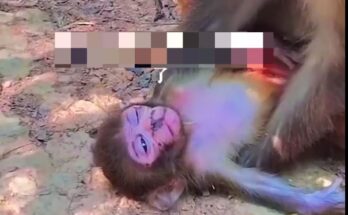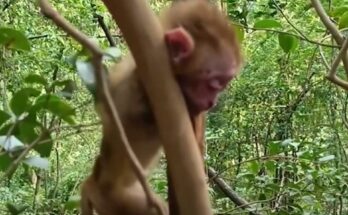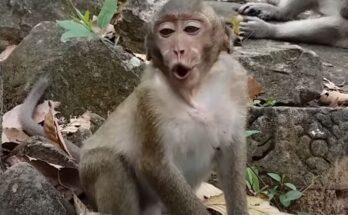The animal kingdom is often a place of survival and competition, where predators and prey engage in a constant dance for existence. However, occasionally, we witness extraordinary moments that defy these primal instincts, offering a glimpse into the complexities of animal behavior. One such remarkable interaction occurred between a leopard and a baby baboon, leaving onlookers in awe and redefining our understanding of the natural world.
This extraordinary encounter took place in the African wilderness, where a female leopard successfully hunted an adult baboon. As the leopard prepared to consume its prey, it discovered a tiny baby baboon clinging to its deceased mother. What followed was an astonishing display of compassion and curiosity that contradicted the leopard’s predatory instincts.
Instead of attacking the vulnerable infant, the leopard exhibited unexpected gentleness. It sniffed the baby baboon, nudging it cautiously, as though trying to understand what it had stumbled upon. The tiny baboon, visibly distressed but too weak to flee, clung tightly to its deceased mother. The scene, already heart-wrenching, took an unexpected turn when the leopard, instead of continuing with its meal, picked up the baby baboon gently in its powerful jaws.
Over the next several hours, the leopard displayed an almost maternal behavior toward the infant. It carried the baby baboon up into a tree for safety, shielding it from other predators. Remarkably, the leopard stayed with the baboon through the night, offering it warmth by curling around it and occasionally licking it, actions commonly associated with a mother caring for her cubs.
This moment of interspecies connection is not entirely unheard of, but it remains exceedingly rare in the wild. Predators like leopards are hardwired for survival and are typically unlikely to show such nurturing behavior toward what is essentially prey. Scientists and wildlife enthusiasts have proposed several theories to explain this anomaly. Some suggest that the leopard’s maternal instincts were triggered, especially if it had lost its own cubs recently. Others argue that the interaction might have stemmed from curiosity or a temporary override of predatory instincts.
Despite the leopard’s care, the baby baboon’s survival prospects were grim. Baboon infants are heavily reliant on their mothers for nourishment, and without the ability to provide milk, the leopard’s care could only offer temporary solace. However, this moment of compassion amidst the brutal realities of nature left an indelible mark on those who witnessed it.
The encounter is a testament to the unpredictable and multifaceted nature of wildlife behavior. It challenges the black-and-white view of predators and prey, reminding us that even in the harsh wilderness, there can be moments of connection that transcend the boundaries of instinct. The story of the leopard and the baby baboon is a poignant example of the complexity of life in the wild, illustrating that compassion is not exclusively human and that animals, too, can exhibit behaviors that defy explanation.
Ultimately, this incredible interaction serves as a reminder of the beauty and mystery of the natural world, urging us to approach it with a sense of wonder and respect. It underscores the importance of conservation efforts to protect such extraordinary creatures and the ecosystems they inhabit, allowing future generations to witness these awe-inspiring moments.


